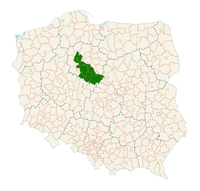
Photo from wikipedia
Abstract In the course of archaeological research at site 2 in Oslonki (Kuyavia, central Poland), a dense deposit of 20 cattle bones was discovered, most of which are semi-finished products… Click to show full abstract
Abstract In the course of archaeological research at site 2 in Oslonki (Kuyavia, central Poland), a dense deposit of 20 cattle bones was discovered, most of which are semi-finished products for production of bone chisels. The collection was dated ab. 3350-3097 calBC. The traceological analysis of technological traces on the artefacts and experimental studies indicate that they were processed using several metal tools with working edges of varying shape, employed as chisels for bone splitting. Although SEM-EDX analyses did not show the presence of a substantial amount of copper on the surfaces of the artefacts, the collection can be considered most likely evidence for widespread use of this metal among Late Neolithic communities in Poland or at least the people who inhabited the area of Kuyavia.
Journal Title: Quaternary International
Year Published: 2017
Link to full text (if available)
Share on Social Media: Sign Up to like & get
recommendations!